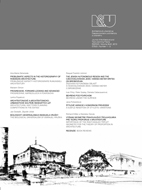ARCHITEKTONICKÉ A ARCHITEKTONICKO-URBANISTICKÉ SOUTĚŽE ŠEDESÁTÝCH LET. Jejich specifický přínos v dějinách Československé architektury
ARCHITECTURAL AND TOWN PLANNING COMPETITIONS IN THE SIXTIES. Their specific contribution to the history of Czechoslovak modern architecture
Author(s): Lenka PopelováSubject(s): Cultural Essay, Political Essay, Societal Essay
Published by: Historický ústav SAV, v. v. i.
Keywords: Czechoslovak architecture; architectural competitions; contemporary architecture; history of architecture
Summary/Abstract: Czechoslovak architecture during the “Golden Sixties” of the 20th century is interpreted by contemporary historians as a very important phase in the history of our modern architecture. In the postwar development of Czechoslovak modern architecture, this decade can even be seen as a time of very radical change – from the political isolation of the 50s to the relative openess of the 60s, from socialist realism to modernity, from neoclassic imitations to forwardlooking solutions inspired by models taken from the West. During the past decade, contemporary historians have interpreted the most remarkable buldings of this era, yet the designs from architectural and urban design competitions of the 1960s have yet be dealt with in the history of Czechoslovak modern architecture. Only the most important competitions have received some attention as part of contemporary monograph studies and newer interpretative publications. The text summarizes the results of the dissertation work which dealt with a selected part of the architectural competitions in this period, concentrating on competitions held in Bohemia and Moravia also including some events not intended for specific locations and important projects for foreign countries. The study covered all types of competitions as legislatively defined in the public notice nr. 154/1959 (Regulations of the State Committee for Construction No. 154/1959 in the Official List of the State Committee for Construction from July 14, 1959 regarding the competitive rules for competitions in conceptual project solutions) yet with a special focus on public competitions. The final criterion defining the object of the study was the publication of the winning and listed designs in professional journals, in this case primarily Architektura ČSR/ČSS (Architecture of the Czechoslovak Socialist Republic) and Československý architect (Czechoslovak Architect), which throughout the 1960s devoted considerable careful attention to these competitions. In total there were, on the basis of the chosen criteria, 229 architectural and urban design competitions selected for discussion. The purpose of the study was to evaluate the specific role of architectural competitions in the 1960s in the development of Czechoslovakarchitecture (and partly also urban planning), to highlight the most progressive and groundbreaking designs in terms of the development of form and typology, to point out the prominent position of Prague with regard to the number of designs realized, and to evaluate the impact of competitions on theoretical discussion, work of particular architects and conservation principles and policy. In genera,, the work sums up the aspects in which the competitions for the development of individual typologies were beneficial – especially in relation to the renaissance of modern architecture at the start of the 1960s, to assess the degree of conventionalism and typicality of the designs, to underscore the relationship of competition designs
Journal: Architektúra & Urbanizmus
- Issue Year: 47/2013
- Issue No: 1-2
- Page Range: 34-51
- Page Count: 18
- Language: Czech

